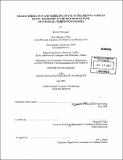| dc.contributor.advisor | Douglas P. Hart. | en_US |
| dc.contributor.author | Thirouard, Benoist (Benoist Pierre), 1972- | en_US |
| dc.contributor.other | Massachusetts Institute of Technology. Dept. of Mechanical Engineering. | en_US |
| dc.date.accessioned | 2005-08-23T16:09:17Z | |
| dc.date.available | 2005-08-23T16:09:17Z | |
| dc.date.issued | 2001 | en_US |
| dc.identifier.uri | http://hdl.handle.net/1721.1/8890 | |
| dc.description | Thesis (Ph.D.)--Massachusetts Institute of Technology, Dept. of Mechanical Engineering, 2001. | en_US |
| dc.description | "June 2001." | en_US |
| dc.description | Includes bibliographical references (p. 253-257). | en_US |
| dc.description.abstract | Engine oil consumption is one of the primary interests for the automotive industry in controlling emissions and reducing service cost. Due to a lack of understanding of the mechanisms of oil transport along the piston, reducing oil consumption from the ring pack of internal combustion engines has been extremely challenging for engine manufacturers and suppliers. This work addressed the fundamental aspects of oil transport in the piston ring pack through experiments and modeling. A two-dimensional multiple-dye Laser-Induced Fluorescence (LIF) visualization system was successfully implemented in a diesel and a spark-ignition engine. Real time high resolution images of the ring pack oil distribution were acquired and analyzed for the entire range of operating conditions typically encountered by passenger car engines. Based on experimental observations, major oil flow patterns in the piston ring pack were identified and characterized. Physically based models were proposed to describe each individual oil transport process, such as, oil flows on the piston lands in both axial and circumferential directions and oil flows through the ring grooves and gaps. Modeling results showed good agreement with the experimental data. | en_US |
| dc.description.abstract | (cont.) Then, using the individual oil transport models, the contributions of the different oil transport mechanisms to oil flow in and between the piston regions and the effects of piston and ring designs were analyzed. Finally, a global oil transport scheme was presented by integrating all major paths and mechanisms of oil transport along the piston. It highlighted that the rate at which oil is lost to the combustion chamber is mostly determined by the competing oil transport processes occurring on the piston lands. While the effect of the inertia force results in a net oil flow toward the top of the piston, the dragging action of the blow-by gases removes oil from the piston lands and recycles it to the crankcase. This work was the first comprehensive investigation of the mechanisms of oil transport in the piston ring pack of internal combustion engines. It constitutes a major step in the development of analytical tools for oil consumption reduction. | en_US |
| dc.description.statementofresponsibility | by Benoist Thirouard. | en_US |
| dc.format.extent | 263 leaves | en_US |
| dc.format.extent | 21231141 bytes | |
| dc.format.extent | 21230902 bytes | |
| dc.format.mimetype | application/pdf | |
| dc.format.mimetype | application/pdf | |
| dc.language.iso | eng | en_US |
| dc.publisher | Massachusetts Institute of Technology | en_US |
| dc.rights | M.I.T. theses are protected by copyright. They may be viewed from this source for any purpose, but reproduction or distribution in any format is prohibited without written permission. See provided URL for inquiries about permission. | en_US |
| dc.rights.uri | http://dspace.mit.edu/handle/1721.1/7582 | |
| dc.subject | Mechanical Engineering. | en_US |
| dc.title | Characterization and modeling of the fundamental aspects of oil transport in the piston ring pack of internal combustion engines | en_US |
| dc.type | Thesis | en_US |
| dc.description.degree | Ph.D. | en_US |
| dc.contributor.department | Massachusetts Institute of Technology. Department of Mechanical Engineering | |
| dc.identifier.oclc | 48853493 | en_US |
